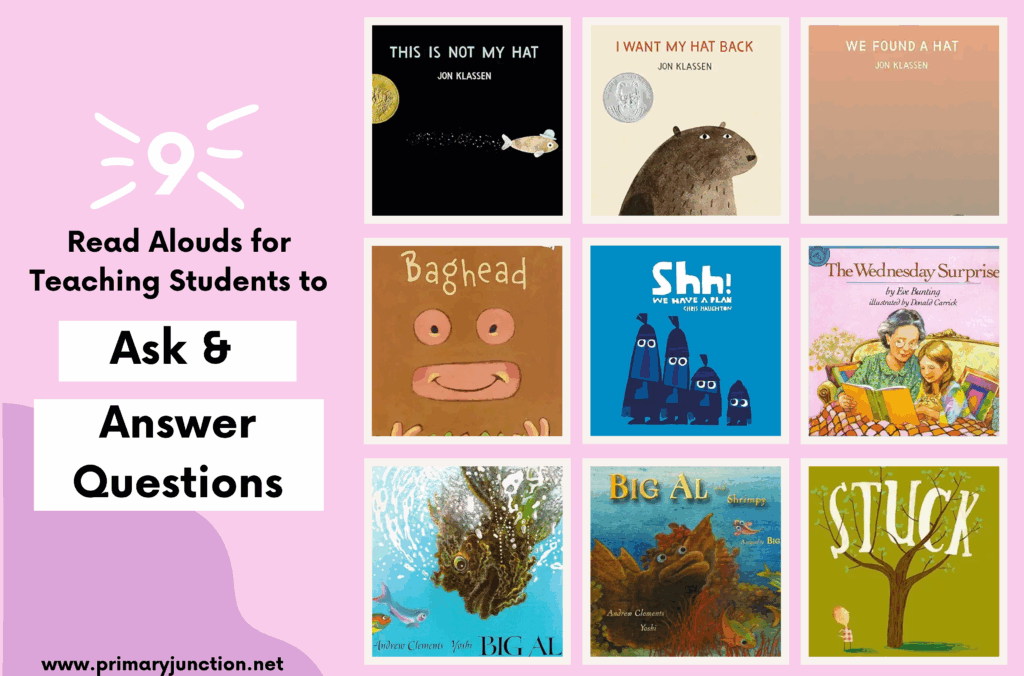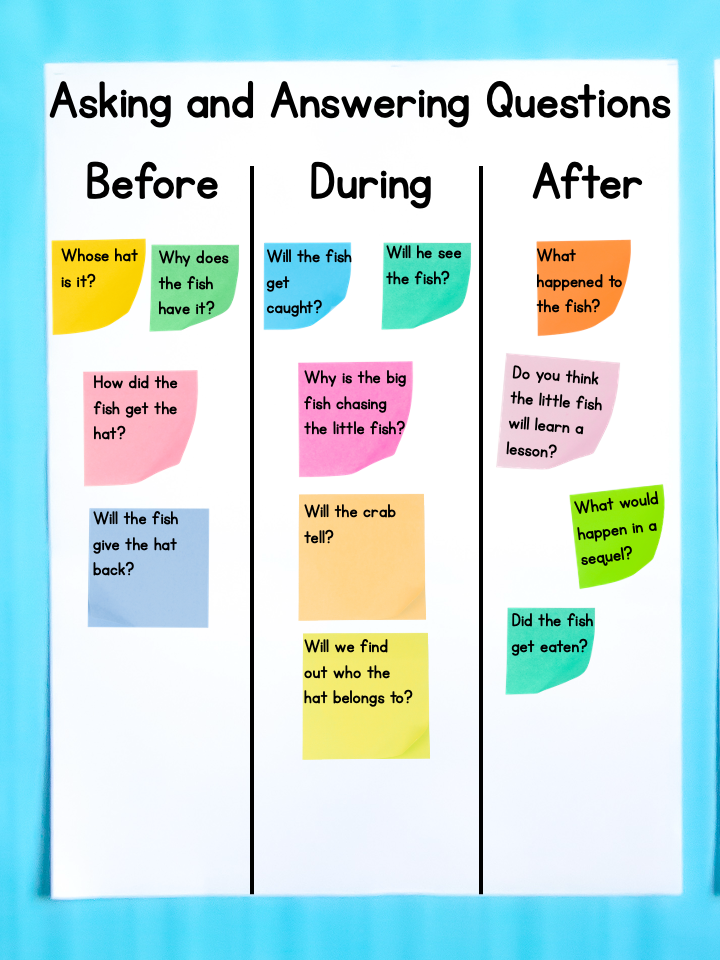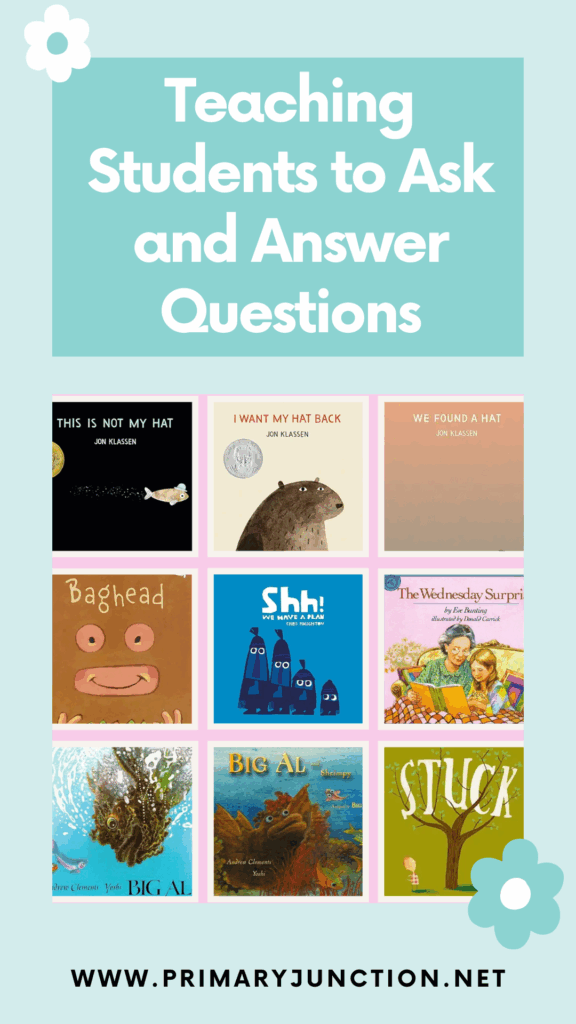How Do I Teach First Graders to Ask and Answer Questions?
Hey teacher friend!
If you’re anything like me, you’re always looking for meaningful ways to boost reading comprehension in your first grade classroom. One of the most powerful skills we can teach our little readers is how to ask and answer questions about a story – before, during, and after reading. It helps them stay engaged, think deeply, and make personal connections to the text. But how do we actually teach that skill to six- and seven-year-olds in a way that makes sense to them?
Let me walk you through how I introduce asking and answering questions in my classroom and how it’s become one of our favorite comprehension routines!

Anchor Charts that Grow with Us
When I introduce this concept, we build a reusable anchor chart together. I keep it simple: divide a big chart paper into three sections: Before Reading, During Reading, and After Reading.

I model using the chart during our read-alouds and invite students to help me add their own questions on sticky notes. The beauty of post-its? You can remove and reuse them each time you ask and answer questions with a new story!
🔍 Before Reading: Making Predictions + Asking Questions
We always start by looking at the title and cover illustration. I’ll model my thinking aloud:
“This book is called This Is Not My Hat and there’s a little fish on the cover. Hmm… I wonder whose hat it is? Why does the fish have it?”
Then I write that question on a post-it and add it under the Before section. I’ll ask students to turn and talk to a partner:
“What do you wonder about this book before we read it?”
Let them generate questions! You’ll be amazed by what they come up with when you give them a voice.
🤔 During Reading: Staying Curious
As we read, we pause to see if any of our before questions have been answered. If they have, we check them off. Students also add new questions that pop up mid-story:
“Why is the big fish chasing the little fish?”
“Will the little fish get caught?”
Again, students talk with a partner, ask and answer questions, and share their thinking. This part really keeps them actively listening and looking for clues in the text.
🧠 After Reading: Reflecting & Wondering More
Once the story ends, we revisit our chart. Which questions were answered? Which ones weren’t?
This is where I teach one of my favorite mini-lessons:
“Sometimes stories don’t answer everything.”
And that’s okay! We might still be wondering what happened after the book ended, or what a character was really thinking.
“Do you think the little fish ever learned his lesson?”
“What would happen next if there was another book?”
These after-reading questions help students think beyond the text and explore inference and imagination.
Independent Practice: Sticky Notes + Book Bins
After we’ve practiced this routine together several times, I send students off with a book from their book bin and 2–3 sticky notes. Their job? Ask their own questions before, during, and after reading.
I encourage them to start with:
- “I wonder why…”
- “What will happen when…”
- “Why did the character…”
They share their questions with a partner afterward, and if time allows, they check off which ones were answered! Sometimes, we also create a class anchor chart to hold all the questions they have asked independently!
How Do We Extend Student Learning On Asking and Answering Questions?
For your high-flyers or when you’re ready to stretch the skills of ask and answer questions a bit, introduce a question matrix. It helps students go beyond simple who/what/where questions and explore more complex ideas like Why did…? and How might…?
I love to pull this out mid-year when students are more confident and ready for a challenge. You can create a laminated class version or give students mini copies to keep in their reading folders!
Favorite Read-Alouds for Asking & Answering Questions
Here are some of my go-to books that are perfect for teaching this skill. Each one sparks curiosity, lends itself beautifully to open-ended questions, and has just the right touch of humor or heart.
By Jon Klassen:
- This Is Not My Hat by Jon Klassen is a clever and humorous story about a little fish who steals a hat from a big fish and thinks he’ll get away with it. With simple text and expressive illustrations, the story leaves just enough unsaid, making readers think deeply about what’s really happening. This book is perfect for teaching students to ask and answer questions because it encourages them to make predictions, infer character thoughts, and wonder about what happens next. The ending especially invites discussion and unanswered questions, which makes it a great tool for building comprehension skills.
- I Want My Hat Back by Jon Klassen is a funny story about a bear who lost his hat. He asks different animals if they’ve seen it, but no one seems to know until he remembers something important. This book helps students practice asking and answering questions by following the bear’s search, thinking about clues, and predicting what will happen. The surprise ending sparks great questions and discussions!
- We Found a Hat by Jon Klassen is a story about two turtles who find one hat. There’s only one, though, and they both like it. What will they do? This book is great for asking and answering questions because it helps students think about the characters’ feelings, make predictions, and wonder how the story will end.
(These are goldmines for before reading predictions and after reading inferences!)
By Andrew Clements:
- Big Al by Andrew Clements is about a big, scary-looking fish who just wants to make friends. But the other fish are afraid of him until something changes. This book helps students ask and answer questions about how characters feel, why they act the way they do, and how things might change. It’s great for making predictions and talking about friendship.
- Big Al and Shrimpy by Andrew Clements is about two very different fish. Big Al is big and kind, and Shrimpy is tiny but smart. Together, they make a great team. This book is great for asking and answering questions because students can wonder how the little fish will help, what might happen next, and how the characters solve problems together.
(These books by Andrew Clements are great for character-focused questions and feelings.)
By Jarrett J. Krosoczka:
- Baghead by Jarrett J. Krosoczka is a silly story about a boy who wears a paper bag on his head and won’t take it off! Everyone wants to know why. This book is great for asking and answering questions because students can make predictions, wonder about the boy’s reasons, and ask questions about how others react. The funny twist at the end makes for great discussion! The illustrations also offer some great clues, so this book can also be used as a good lesson on reading the illustrations, as well!
By Chris Haughton:
- Shh! We Have a Plan by Chris Haughton is about four friends who quietly try to catch a bird, but things don’t go as planned! This book is great for asking and answering questions because students can predict what will happen next, ask why the characters act the way they do, and think about what might happen if the story continued. (This book is perfect for sequencing and making predictions.)
By Oliver Jeffers:
- Stuck by Oliver Jeffers is a funny story about a boy named Floyd who gets his kite stuck in a tree and throws all sorts of things to try to get it down. This book is great for asking and answering questions because students can predict what Floyd will throw next, ask why he makes silly choices, and wonder how the story will end. It’s perfect for sparking curiosity and laughter! (This is seriously one of the best books for wondering what will happen next and laughing while doing it!)
By Eve Bunting:
- The Wednesday Surprise by Eve Bunting is about a girl named Lily who plans a special surprise for her mother. This book is great for asking and answering questions because students can wonder what the surprise is, ask how Lily feels, and think about what might happen next. It helps with understanding feelings and making predictions.
(This book is wonderful for discussing surprises, feelings, and deep questions after the story ends. It’s great for teaching empathy, too.)
(Note: The links above are Amazon affiliate links, which means I may earn a small commission at no cost to you if you make a purchase.)
Teaching First Graders How to Ask and Answer Questions
Teaching first graders to ask and answer questions isn’t just a comprehension strategy. It’s a way to help them own their reading. When they’re curious and invested in the story, their comprehension grows naturally.
Start simple, stay consistent, and celebrate those sticky-note questions like the treasures they are.
If you give this strategy a try or have favorite books for questioning, I’d love to hear about them in the comments or over on Instagram!
Happy reading!










